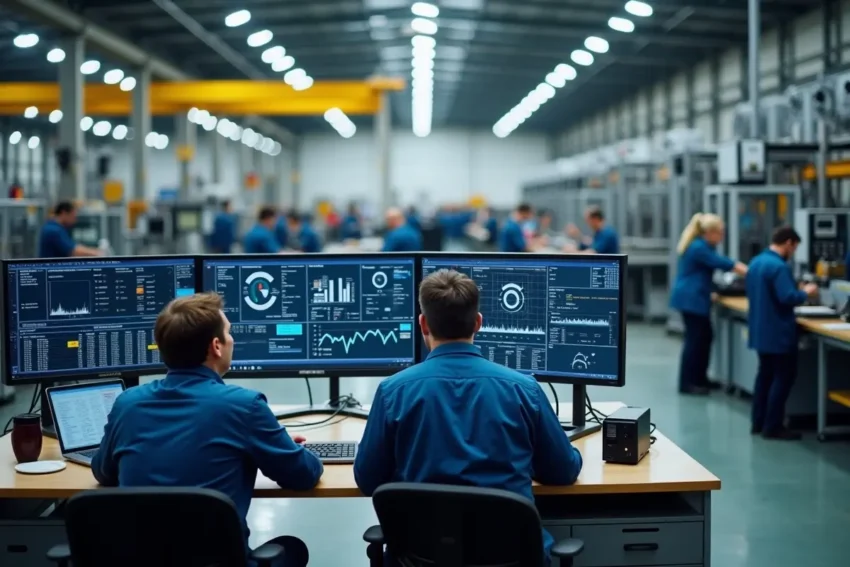Manufacturers and distributors are adjusting to increasing consumer expectations and a rapidly changing global landscape. By adopting data-driven methods and digital tools, they enhance accuracy, simplify operations, and make quicker, better-informed choices. Technologies like advanced analytics, automation, and real-time connectivity help teams forecast demand, manage inventory efficiently, and detect equipment problems early to prevent disruptions.
This digital approach not only boosts efficiency but also promotes agility and resilience, enabling organizations to respond swiftly to market changes. When analytics are integrated into daily decisions, companies gain a competitive advantage—fostering sustainability, reducing costs, and setting industry benchmarks.
Embracing Digital Transformation
Embracing digital transformation is reshaping how manufacturing and distribution companies make decisions, driving efficiency and adaptability across every stage of operation. By leveraging real-time data, automation, and advanced analytics, organizations can identify production bottlenecks, optimize inventory levels, and forecast demand with greater precision.
This shift toward data-centric management enhances responsiveness to market changes and customer needs, thereby improving overall business performance. Integrating tools such as manufacturing pricing software enables businesses to analyze their cost structures, track material fluctuations, and set more accurate and competitive prices.
As digital systems become central to strategic planning, decision-making evolves from intuition-based to evidence-driven, helping companies achieve greater transparency, consistency, and long-term profitability in an increasingly complex supply chain environment.
Enhancing Inventory Management with AI
For manufacturers and distributors, inventory management remains a perennial challenge. Overstock ties up capital and space, while running short on risks, missing sales, and having lower customer satisfaction. The age of guesswork is over—AI-powered forecasting and optimization tools are now empowering teams to maintain just the right inventory levels.
AI algorithms analyze historic trends, supplier performance, and even external factors such as market news or seasonal trends. By doing so, they minimize costly stockouts and overstocks, smooth out seasonal fluctuations, and enhance customer satisfaction through improved delivery reliability. As inventory is managed more precisely, businesses can free up working capital and allocate resources where they are most needed.
Implementing Predictive Maintenance
Breakdowns and unscheduled downtime have long plagued manufacturing floors, often resulting in high maintenance costs and missed delivery deadlines. For many companies, unexpected equipment failure represents one of the greatest threats to productivity and profitability. Predictive maintenance leverages machine learning to monitor sensors and historical failures, flagging issues before they escalate into major disruptions.
Instead of relying on rigid calendar schedules—which may result in unnecessary maintenance or expensive breakdowns—AI-driven tools identify subtle warning signs, such as unusual temperature spikes or vibrations, and trigger inspections only when they’re truly needed. This transition from reactive and preventive strategies enables smoother production flows and extends equipment lifespan, while also reducing reliance on emergency repair technicians.
Utilizing Digital Twins and the Metaverse
Digital twins create virtual representations of physical assets or processes, enabling the simulation, monitoring, and diagnosis of operations in real-time. By creating high-fidelity models of machines, systems, or entire facilities, organizations can experiment with changes in virtual space before investing in physical adjustments.
By integrating these models with the metaverse, manufacturers can host virtual factory tours, conduct hands-on training in immersive settings, and test scenarios before actual implementation—helping to prevent costly mistakes.
This leap forward aligns with trends seen in leading manufacturing hubs, where digital twins are driving vast improvements in agility and decision-making speed. For example, new products can be tested digitally for manufacturability, while logistics scenarios are modeled to find optimal flows. This holistic view accelerates decision-making, enhances collaboration among distributed teams, and contributes to safer, more efficient factories.
Strengthening Supply Chains with AI and Blockchain
The application of AI in the supply chain provides unparalleled visibility and control. Machine learning models analyze thousands of dynamic variables to generate accurate demand forecasts and optimize shipping schedules in real-time. These advanced analytics enable organizations to proactively identify risks, such as supplier delays, geopolitical disruptions, or labor shortages, empowering leaders to take corrective action sooner.
Meanwhile, blockchain technology adds a vital layer of trust, enabling everyone from suppliers to end customers to track goods transparently. Digital records cut down on paperwork, prevent duplicate transactions, and improve regulatory compliance. Incorporating AI and blockchain can greatly boost supply chain resilience, especially during major global disruptions, helping companies foster trust with partners and customers.
Overcoming Traditional Supply Chain Limitations
Legacy systems restricted supply chain performance due to siloed data and slow decision cycles. Manual processes, outdated spreadsheets, and incompatible software left organizations lagging behind, unable to quickly spot market opportunities or react to unexpected events. Today, AI-powered analytics platforms drive real-time decisions by breaking down barriers to communication and workflow integration.
These platforms integrate input from sensors, ERP systems, and external data sources, providing a comprehensive view across the business. Organizations benefit from early alerts about disruptions, pricing opportunities, or shifts in demand, thereby transforming their ability to maintain business continuity and deliver value under all circumstances.
Conclusion
Incorporating advanced technologies within manufacturing and distribution operations has shifted from optional to absolutely necessary. As digital transformation becomes a pillar of the modern industrial landscape, organizations that invest in smarter decision-making tools stand to gain the greatest rewards—enhanced competitiveness, greater operational reliability, and a future-proof business model that is ready to meet new challenges head-on.
Successful organizations continually refine their approach, reviewing outcomes and making adjustments based on data, not gut feeling. The leaders of tomorrow will be those who embrace digital transformation holistically and invest in their people as much as they do in their technology.

